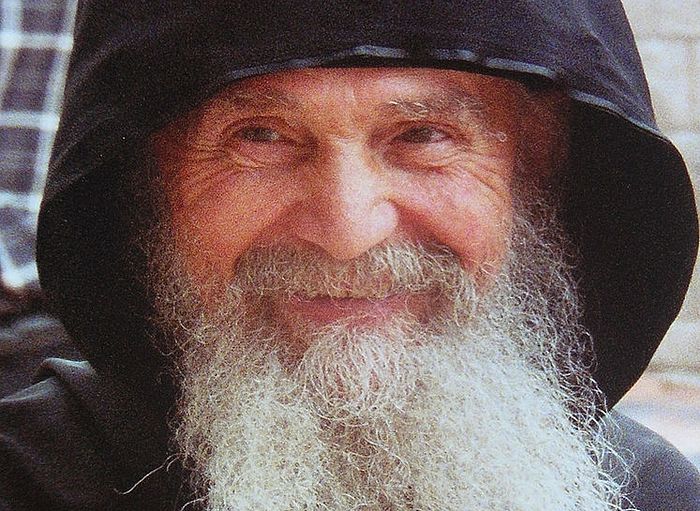 Elder Ephraim is a spiritual child of the great Elder Joseph the Hesychast, and wrote about his spiritual father in the amazing book My Elder Joseph the Hesychast. Elder Ephraim became known as “of Philotheou” from 1973 when he was elected abbot of the monastery of Philotheou on Mt. Athos and in no time revived the ascetic monastic life there. After that the Sacred Community of the Holy Mountain blessed Elder Ephraim to expand and fill three other Athonite monasteries with those seeking the monastic life: Xeropotamou, Konstamonitou, and Karakallou. These monasteries remain under the spiritual guidance of Archimandrite Ephraim, as are a number of men’s and women’s monasteries in Greece and North America.
Elder Ephraim is a spiritual child of the great Elder Joseph the Hesychast, and wrote about his spiritual father in the amazing book My Elder Joseph the Hesychast. Elder Ephraim became known as “of Philotheou” from 1973 when he was elected abbot of the monastery of Philotheou on Mt. Athos and in no time revived the ascetic monastic life there. After that the Sacred Community of the Holy Mountain blessed Elder Ephraim to expand and fill three other Athonite monasteries with those seeking the monastic life: Xeropotamou, Konstamonitou, and Karakallou. These monasteries remain under the spiritual guidance of Archimandrite Ephraim, as are a number of men’s and women’s monasteries in Greece and North America. In 1960 the Greek Orthodox priest and theologian Archpriest John Romanides wrote: “Athonites should immediately send their representatives to the US and found there monastic habitations, otherwise Orthodoxy on the American continent awaits its inevitable doom.” A few years later these prophetic words were realized in the life and efforts of just one man. The monasteries of Elder Ephraim have appeared in many regions of the US and Canada: New York, Texas, Florida, Washington, North Carolina, Pennsylvania, Illinois, California, Michigan, Montreal and Toronto. Chief among these is the Holy Monastery of St. Anthony the Great in Arizona. And now the elder is also often recognized as “of Arizona.”
We present our readers with a conversation with his spiritual child, a very interesting person, Alexandra Lagos. She was also nourished by Gerontissa Macrina, abbess of the Monastery of the Panagia Hodigitria near the Greek city of Volos, founded with the blessing of the great elder Joseph the Hesychast. According to the testimony of the sisters, Gerontissa Macrina greatly loved Alexandra and often remembered her name in conversations with people. Alexandra is acquainted with many ascetics of piety of modern Greece, even having conversed with Venerable Paisios the Athonite. St. Paisios said to her about her spiritual father Elder Ephraim: “You have such a great elder!”
Alexandra is a professor of history and archaeology, working many years in the history faculty at the Medical University of Ioannina (Northern Greece). With the blessing of her spiritual father she always tries to base her work on the Patristic tradition and to teach on the foundation of the Orthodox worldview. Monastics, spiritual fathers, superiors of the monasteries of Elder Ephraim and his lay spiritual children often stay in the house of Alexandra and her husband George Lagos, who is a professor of neurology in the same medical university.
Alexandra has been fortunate not only to become closely acquainted with and a friend to many spiritual children of Elder Ephraim, but also to have visited his monasteries many times for extended stays both in Greece and in America. Her family has always rendered (and does so until now) help to the elder and support in his labors. Thus it is possible to say that the building of the elder’s monasteries occurred in front of her eyes. Alexandra currently lives in Arizona not far from the monastery of St. Anthony the Great, and with the blessing of the elder leads catechism classes and Sunday talks for pilgrims to the monastery, and also offers lessons in Ancient and Modern Greek for all who are interested.
* * *
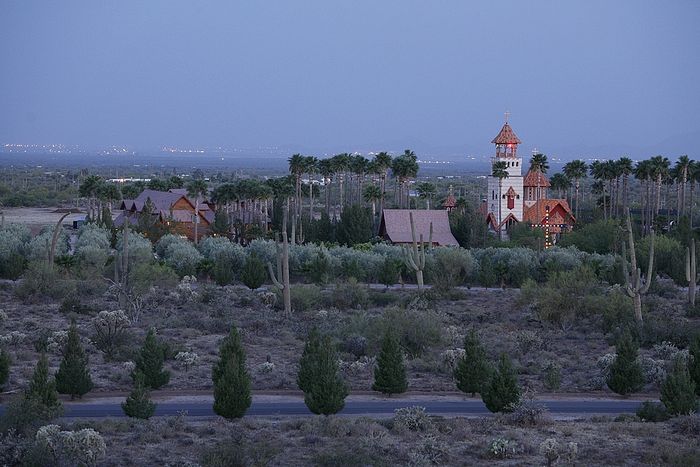 St. Anthony's Monastery
St. Anthony's Monastery —Alexandra, could you tell us about how you came to be under the guidance of Elder Ephraim?
—My husband and I have been spiritual children of Elder Ephraim for thirty years already. We learned about the elder in 1986 and by the grace of God he became the spiritual father for our whole family. On the first day of our acquaintance the elder shared with us with great enthusiasm his plans regarding “his great work,” that is, the building of monasteries.
We all know that Elder Ephraim has built eighteen monasteries in North America. Paralleled with the founding of these new monasteries in North America he revived ancient Greek monasteries, destroyed and abandoned since the time of the Turkish yoke. In Greece, as in Russia, many beautiful monasteries found themselves, and still find themselves in desolation, due to a lack of means for their restoration and of potential inhabitants. So the first half of the elder’s “great work” occurred in North America, and the second half in Greece.
—Alexandra, has your spiritual father spoken to you about his elder—Joseph the Hesychast? Was it revealed to the great Elder Joseph that his spiritual son would build monasteries?
—The spiritual children of Elder Ephraim often call Elder Joseph “Grandpa” since he’s the spiritual father of their spiritual father. When Grandpa Joseph was still alive he told Elder Ephraim that he had received word from the Lord that a great work awaits Elder Ephraim in the future. Grandpa Joseph made sure that his spiritual son ate well, and would say to him: “Eat, eat, my little one, you have before you a great podvig; you will do much work.”
In his book Elder Ephraim mentions that once Elder Joseph said to him: “The hour is coming when you will speak in the midst of the church.” Elder Ephraim then thought: “Our little skete church has trouble holding three people. Just think, what a great thing if I ever have to speak in the middle of it!”
Elder Ephraim received a very strict spiritual education from his elder. Elder Joseph didn’t relate to any of his other novices so strictly as he did to Elder Ephraim—precisely because he knew what labor awaited him in the future.
Before Elder Joseph departed to the Lord he divided his disciples—who should stay with whom after his death. In obedience to Fr. Ephraim he placed Fr. Joseph who then for many years served in Portaria. Elder Joseph also entrusted Fr. Ephraim to take under his spiritual direction the women’s community in Volos. Elder Ephraim’s mother lived in this sisterhood, and the gerontissa Macrina (Maria at that time). This community later gave rise to the famous convent in Portaria.
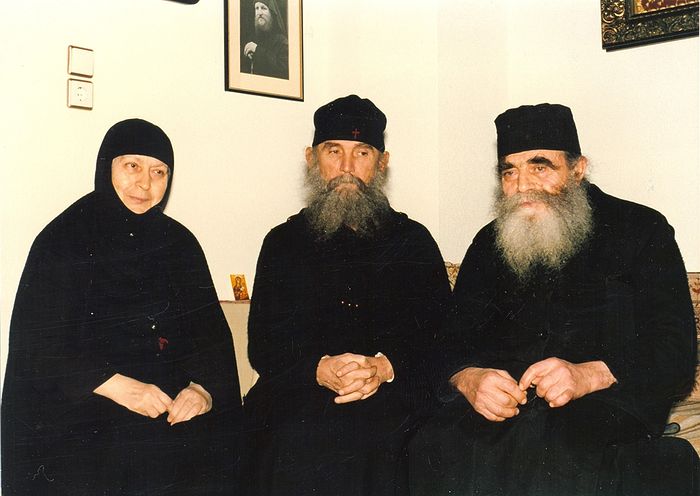 Gerontissa Macrina, Elder Ephraim, Fr. Joseph
Gerontissa Macrina, Elder Ephraim, Fr. Joseph —Alexandra, could you tell us how, thanks to Elder Ephraim, this monastery became the “mother convent” for many other women’s monasteries?
—Among the spiritual children of Elder Ephraim the unofficial name of “metropolia” for the monastery in Portaria was entrenched. The word “metropolia” (Gk. Μητρόπολις) is translated as “mother city,” from μητέρα—“mother” and πολις—“city.” In Greek cities it’s the most ancient part of the city from which comes, or figuratively speaking, “is born” the rest of the city. In the case of the Portaria monastery it’s considered that it became like a “mother monastery” for the elder’s other female monasteries. This is how it happened.
Under the direction of such great ascetics as Elder Ephraim and Gerontissa Macrina, the sisters of the monastery in Portaria began to spiritually prosper very quickly and were filled with every virtue. When the elder began to open one monastery after another, first in Greece and then in America, he needed spiritually experienced nuns, being well-acquainted with those traditions which he and Gerontissa Macrina imbibed from Grandpa Joseph. It was precisely such nuns that Elder Ephraim aimed to make the first inhabitants of his monasteries, so that they might then hand on as an inheritance the spiritual traditions of Elder Joseph the Hesychast to the next generation of monks and nuns.
—Which monasteries were opened?
—At first Elder Ephraim managed to persuade Igumena Macrina to release a few sisters to the first two monasteries he opened in Greece—of the Prophet and Forerunner John in Serres Township and of the Archangel Michael on the island of Thassos.
In the early 1980’s Elder Ephraim relocated his mother, Nun Theophano (†1986), and other sisters to the newly-opened Philotheou metochion on the island of Thassos. Gerontissa Ephraimia, who until the present day is the superior of the Thassos monastery, was at that time a young girl from the city of Volos. She often visited the monastery in Portaria and knew Elder Ephraim, Gerontissa Macrina, Gerontissa Theophano—you could say she grew up in their hands.
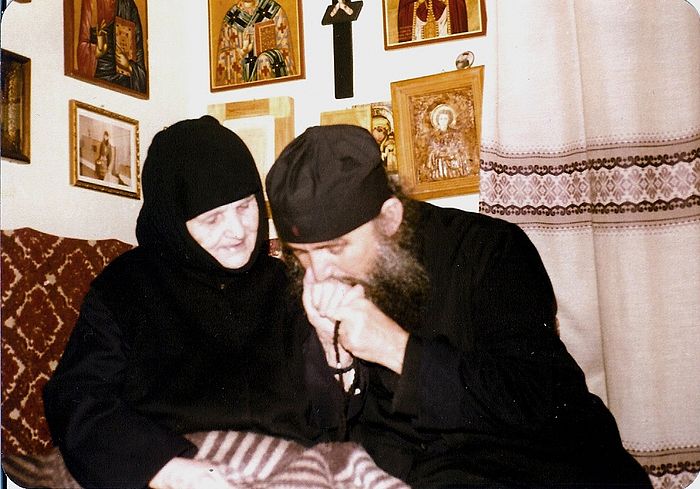 Elder Ephraim with his mother, Nun Theophano
Elder Ephraim with his mother, Nun Theophano Then Elder Ephraim took from Portaria four sisters: Fevronia, Markella, Thekla, and Vriani, and opened a monastery in Serres, establishing Nun Fevronia as the igumena. After that, Gerontissa Macrina said she wouldn’t give up any more sisters from her monastery. When Elder Ephraim entreated her about it, the gerontissa replied: “As long as I live, I cannot give any more.” She was a very sensitive person and loved her sisters, and seeing the difficulties which they endured after leaving the monastery, like a good mother, she had much pity and worry for them.
—In these same years Elder Ephraim begins to build monasteries in America…
—Yes, in those same years Elder Ephraim began to regularly visit North America—Canada and America. At first he traveled there one-two months a year. The elder saw that many Greek immigrant families were in need of spiritual support—confession, the services, the word of God. Once one man, a spiritual child of the elder, invited him to Hawaii in order to confess the local Orthodox. There Elder Ephraim had a vision. He saw Grandpa Joseph, who poured out onto his lap an abundance of oranges with the words: “You will plant oranges, dear one! You will see how much fruit there will be!” from which he understood that he needed to labor in America.
During those ten years that Elder Ephraim would visit America, he realized that one-two months a year would not suffice. It was necessary to begin constructing monasteries in America. He also received a revelation from the Lord that it was necessary to build monasteries. This is how the elder told us about it in conversation. At first he didn’t want to accept this “great work” of building monasteries. He prayed to the Lord, telling Him that he was not able to accept this work. In one moment he heard the voice of Christ, Who said to him: “No, you will render to Me obedience and take this work to yourself.” Then the elder answered: “Alright, Lord, but only grant me so much love as to be enough for all the people who will come to me.”
Where did twenty (monasteries in North America) come from? In his work Gifts of the Desert (2005) Kyriakos Markides notes that the elder’s task was to build in America as many monasteries as there are on Holy Mount Athos. Why did he have to build monasteries precisely in America? The elder said in conversatoin that the work of building monasteries is for the last times when the “enemy” (antichrist) will come, and in America because it’s from there that it all will begin, and people here are in need of spiritual nourishment and help.
—Which convents in America were opened by Elder Ephraim? Which of his nuns became the gerontissas in these monasteries?
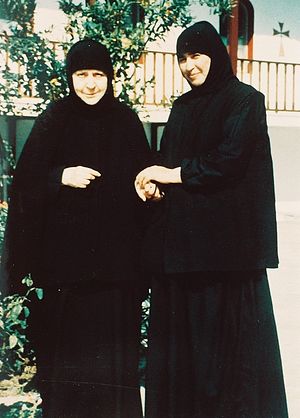 Gerontissa Macrina, Gerontissa Taxiarchia —The elder’s first monastery in America, opening in 1989, was the monastery of the Nativity of the Theotokos in Pennsylvania. The first gerontissa of the elder in America was Gerontissa Taxiarchia († 1994) of blessed memory.
Gerontissa Macrina, Gerontissa Taxiarchia —The elder’s first monastery in America, opening in 1989, was the monastery of the Nativity of the Theotokos in Pennsylvania. The first gerontissa of the elder in America was Gerontissa Taxiarchia († 1994) of blessed memory. Gerontissa Taxiarchia was a holy soul, chosen of God. She had such great spiritual gifts like Gerontissa Macrina had. After her repose Elder Macrina spoke thus about her: “She never once upset me, never once opposed me. She was an angel.” Gerontissa Macrina was much attached to her and very worried about her. Gerontissa Taxiarchia was an exceedingly beautiful, kind, gentle and smiling woman. She didn’t have any of that sternness in her which we often see in monastics.
After Gerontissa Taxiarchia left for America in 1989 she wrote letters to Gerontissa Macrina in which you could feel her pain: it was evident how difficult it was for her to live so far from her home monastery, in a foreign land, without language, not having a single acquaintance, not even anyone to pray with—for the first time she was completely alone in a monastery. Gerontissa Macrina flew to America once to visit her beloved, and to see with her own eyes all these difficulties. It confirmed for her the decision not to release any other sisters from the monastery.
Therefore, although Elder Ephraim would have preferred to take all the sisters from Portaria for America, but whereas Gerontissa Macrina said “As long as I live, I cannot give any more,” he began to take sisters for America from the monasteries on Thassos and Serres.
There was a turning point, some instruction from above on the day of Gerontissa Taxiarchia’s burial. She lived less than five years in America and departed to the Lord on August 3, 1994, having died from cancer. Practically the whole spiritual family of Elder Ephraim gathered at her funeral in Pennsylvania: Gerontissa Macrina and several other sisters from Greece flew in, the American gerontissas gathered, and from the Holy Mountain came Elder Ephraim himself.
Not long before the burial a miracle occurred: on the forehead of the reposed Gerontissa Taxiarchia there appeared myrrh in the form of drops, looking like droplets of sweat, but emitting a wondrous fragrance. All present saw this miracle. It made such a strong impression on Gerontissa Macrina that she agreed to give up her sisters to America.
In October 1994 Elder Ephraim agreed with Gerontissa Macrina about which sisters he could take and in May 1995 a few nuns moved from Portaria to America. Gerontissa Macrina wept, sending her spiritual children to America. In doing so she said: “What other mother has worried so much as I have? So many children to raise, educate—so you can take them right out of my hands!” Not that she didn’t want to give them to God—her whole life was given to God, but she, as a mother, was very sensitive and strongly attached to her sisters, wanting to protect them from dangers, seeing their difficulties after they left her monastery. It was her cross.
Gerontissa Eupraxia came to the monastery at the age of eighteen and left Portaria for America around fifty years of age. Thus, she spent many years together with Gerontissa Macrina. She came to America for the burial of Gerontissa Taxiarchia and afterwards the elder invited her for a walk and announced to her that he wanted her to move to America and become the abbess of a new monastery. This occurred in August 1994.
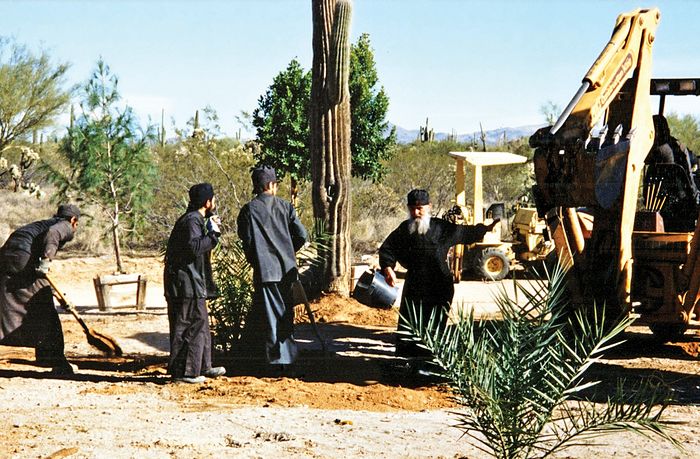 Planting trees, Elder Ephraim working along with the brethren
Planting trees, Elder Ephraim working along with the brethren —What difficulties did Elder Ephraim encounter in building his monasteries in America?
—Building monasteries in America was not easy. There, even amongst the Orthodox, there can be felt a totally different religious tradition—the tradition of secularism. But Elder Ephraim managed to achieve amazing results, making wise decisions—in part thanks to Divine illumination, in part with the help of his amazing character—he is a very smart and clever person and does any work quickly and beautifully.
The elder saw that it was necessary to do everything quickly. He would constantly say: “We must hasten to make it in time—hard times are soon coming in the world.” Nevertheless, he met great resistance on the part of Archbishop Iakovos (Koukouzis), who at first did not give a blessing for the building of the monasteries. Gerontissa Taxiarchia had a hard time because she was completely alone, but she was a holy soul and had a multitude of gifts.
The elder soon realized that he would not receive a blessing from the Greek Church to build more monasteries in America. At this time he became acquainted with some hierarchs of the Russian Church Abroad and they offered him their help. When the elder spoke about this offer in Greece it caused a wave of condemnation from many of his acquaintances and official Church personalities and he came into a very difficult situation. They told him that the Russian Orthodox Church Outside of Russia (ROCOR) was a non-canonical Church. Many then called the elder deceived.
When this all was happening the elder reached the state of abandonment by God: My God, my God, why hast Thou forsaken me!” At the same time, his spiritual children testify that in this difficult period Elder Ephraim had so much grace that he exuded a sweet fragrance. Everything the elder touched began to sweetly smell. When he confessed children, covering their heads with his epitrachelion, their hair had this fragrance for a few days. If he touched napkins they began to emit this fragrance. His clothes and skufias emitted the fragrance. The stronger were the temptations, the stronger this fragrance was felt. Not just Elder Ephraim himself, but his spiritual children received revelations from the Lord that what the elder was doing was from God.
In the end, after a few months the elder received a blessing from the Ecumenical Patriarch to build monasteries. Archbishop Iakovos, who had been an opponent of the construction, had by that time departed to the Lord. His successor was the monastic-loving Archbishop Spyridon (Papageorgiou, 1996-1999). Then Elder Ephraim began to open monasteries one after the other.
The elder managed just in time. Archbishop Spyridon resigned from his post in 1999 and a difficult period again began for the elder. This is what he had to say about it: “The more struggles I have, the more I love this work,” and, “Great work comes in great steps. We must hurry to accomplish everything,” and, “Who can withstand the will of God?!” The spiritual children of the elder say that he always spoke to them about his “great work” with great enthusiasm and love. His work came through much suffering, accompanied by many difficulties and, and his face was washed with streams of prayerful tears. In Greece there is no other such example, no other such person, who could have done such a work with his life.
—Alexandra, how many monasteries are now under the spiritual direction of Elder Ephraim?
—There are currently eighteen monasteries in America, and the elder is the spiritual father of four monasteries on Mt. Athos and of eight women’s monasteries in Greece. Besides these there are a few brotherhoods and sisterhoods not having the status of monasteries (so-called “sketes” of the elder).
Thus, the work of Elder Ephraim is unique. The Lord prepared him and gave much grace and great boldness to complete this “great work.” Well, and, of course, prayer. The elder mentioned in his talks that he never makes a serious decision without having received word from God on how to proceed. How he receives these notifications from God is a mystery for us. We can’t understand. But all of his decisions about which monks or nuns to appoint igumen or igumena he made only after ardent prayer and some word from God. Such a great work could never have been accomplished by the strength of one man. How can one person manage to do so much in his life? How many brotherhoods and sisterhoods were created in America, Greece, on the Holy Mountain, how many laymen and Orthodox families the elder nourishes!
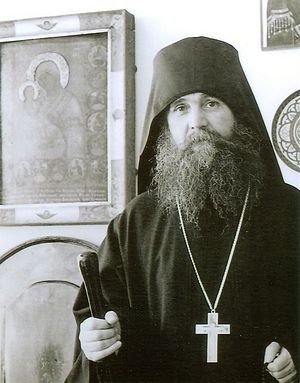 Elder Ephraim, when he was abbot of Philotheou Monastery Yes, Elder Ephraim received a worthy education from Grandpa Joseph. Grandpa Joseph had schooled him in unconditional obedience because he knew that after his death Elder Ephraim would have to render obedience to Christ Himself, and it is exceedingly more difficult. Just imagine, was it easy for Elder Ephraim to leave the Athonite Philotheou Monastery, so wonderful, blessed, beautifully-organized, and pass it into the hands of his pupil in order to roam somewhere far from his Motherland?!
Elder Ephraim, when he was abbot of Philotheou Monastery Yes, Elder Ephraim received a worthy education from Grandpa Joseph. Grandpa Joseph had schooled him in unconditional obedience because he knew that after his death Elder Ephraim would have to render obedience to Christ Himself, and it is exceedingly more difficult. Just imagine, was it easy for Elder Ephraim to leave the Athonite Philotheou Monastery, so wonderful, blessed, beautifully-organized, and pass it into the hands of his pupil in order to roam somewhere far from his Motherland?! Then he began to erect monasteries, deciding where and how to build. He had to not only decide which sisters to take from Greece or America for each one of them, but to attract the help of local Orthodox families for purchasing a piece of land for building. Many families took money from their accounts to pay for the purchase of land for building the monasteries.
Every monastery has its story about how the elder decided which plot of land to buy and what and how to build. Awaiting the arrival of the first monks and nuns in every new monastery, the elder took care to prepare well their new homes, and make them cozy and attractive. He would personally deliver bouquets of fresh flowers, place in the gardens cute little sculptures of animals, and fille the refrigerators with fresh products on the eve of their arrival.
The elder took great care to ensure that the fathers or sisters had every necessity to immediately begin normal monastic life in their new place. However, there eventually came the moment when he had to leave and the immigrants were left alone to continue on their own what the elder had begun. And he would leave, carrying on his shoulders the burden of caring for another new monastery.
Elder Ephraim also says that he is always helped by the prayerful intercessions of his elder, Grandpa Joseph. “I have never done anything without the blessing of my elder. I leave and enter my cell and every time I mentally take a blessing from my elder,” Elder Ephraim tells his spiritual children. And Grandpa Joseph is a great man of prayer and aid not just for Elder Ephraim in his labors, but for all.
—We thank you, Alexandra, for this wonderful conversation!
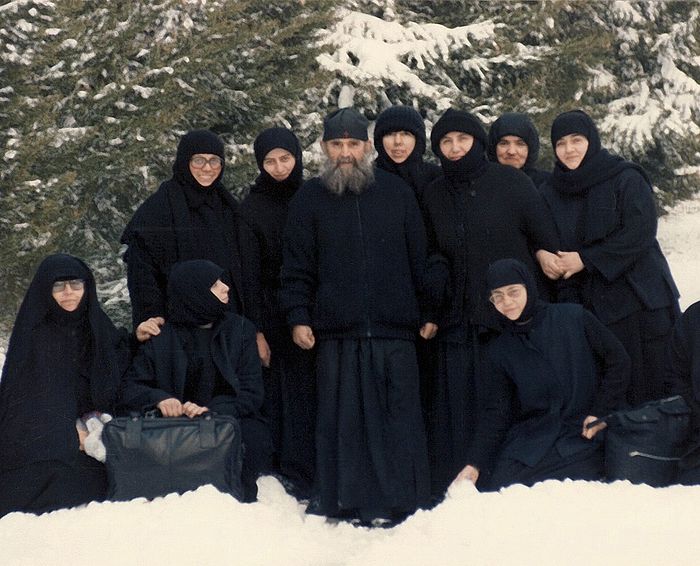 Elder Ephraim with sisters in North America
Elder Ephraim with sisters in North America * * *
Hierodeacon of the Monastery of St. Anthony the Great in Arizona, Fr. Seraphim (Molibog) has offered a small addition to our conversation, expanding on some points from our conversation with Alexandra Lagos:
—The first monastery opened by the elder in America was the women’s Monastery of the Nativity of the Theotokos near Pittsburgh in Pennsylvania, in 1989. Unfortunately, because of the secularization of the Greek Church in North America the elder was resisted and they didn’t allow him to open other monasteries. They even tried to expel him from the country. Then he, I am sure by Divine revelation, switched to the jurisdiction of ROCOR (the monastery of the Nativity of the Theotokos remained in the Greek Archdiocese). The ROCOR synod accepted Elder Ephraim with great love and said to him: “Elder, open monasteries and bring monks and nuns from Greece to inhabit them.”
With great love Elder Ephraim recalled that time and said that he met holy people in the Russian Church, both bishops and priests. His meeting with Archbishop Constantine (Yesensky), vicar of the Eastern American Diocese who reposed on May 31, 1996 and whose remains were discovered to be incorrupt when they were transferred in December 2014 from Texas to the Holy Trinity Monastery in Jordanville, NY, made a particular impression on him.
Upon meeting they fell at one another’s feet, asking one another’s blessing. Vladyka Constantine’s appearance made an indelible impression on the elder: he wore a threadbare skufia, “like a monk from Karoulia on Athos.” The elder also very much liked the pious Russian Orthodox immigrants.
When news of the elder’s transfer to ROCOR reached Athos and the Ecumenical Patriarch there arose, unfortunately, a storm of misunderstanding and indignation from some people. The Ecumenical Patriarch demanded an explanation from the elder. The Greek Archdiocese asked the elder to return and promised to let him open monasteries. The elder realized that the best solution to this very difficult situation would be to return to the Greeks, which he did in the course of about a year after leaving. He later said: “If not for the protests I would have stayed in the Russian Church Abroad.”
By the time of the opening of the monastery of St. Anthony the Great in Arizona in the summer of 1995 the elder managed to open six more monasteries. In 1996 His Eminence Spyridon became the archbishop of the Greek Church in America. He very much supported the elder, and during his service (July 30, 1996-August 19, 1999) the elder opened eight more monasteries. Elder Ephraim opened the last two monasteries after Archbishop Spyridon’s retirement.
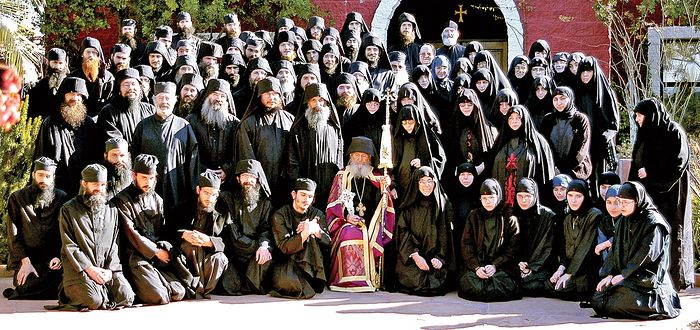 Elder Ephraim with spiritual children
Elder Ephraim with spiritual children * * *
Monasteries founded by Elder Ephraim in North America:
1. Holy Monastery of the Nativity of the Theotokos, Saxonburg, PA
2. Holy Monastery of St. Kosmas Aitolos, Bolton, Ontario, Canada
3. Holy Monastery of Panagia Parigoritissa, Brownsburg, Quebec, Canada
4. Holy Monastery of St. John Chrysostom, Pleasant Prairie, Wisconsin
5. Holy Protection Monastery, White Haven, PA
6. Holy Monastery of the Theotokos, the Life-Giving Spring, Dunlap, CA
7. Holy Monastery of St. John the Forerunner, Goldendale, WA
8. Holy Monastery of St. Anthony, Florence, AZ
9. Holy Archangels’ Monastery, Kendalia, TX
10. Holy Monastery of Panagia Vlahernon, Williston, FL
11. Annunciation Monastery, Reddick, FL
12. Holy Trinity Monastery, Smith Creek, MI
13. Holy Monastery of Panagia Prousiotissa, Troy, NC
14. Panagia Pammakaristou, Lawsonville, NC
15. Holy Monastery of St. Nektarios, Roscoe, NY
16. Holy Transfiguration Monastery, Harvard, IL
17. Holy Monastery of St. Paraskevi, Washington, TX
18. Holy Monastery of the Dormition of the Theotokos, Conchise Stronghold, AZ
http://www.pravoslavie.ru/english/96543.htm